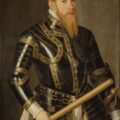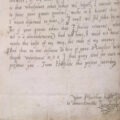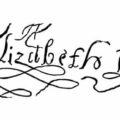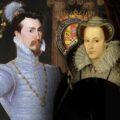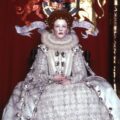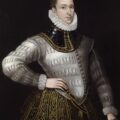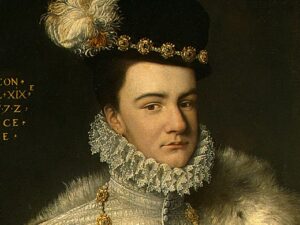
On this day in history, 10th June 1584, François, Duke of Anjou and Alençon, died at the age of 30 from a fever, possibly malaria. Why am I writing about him here, on a website dedicated to Elizabeth? Because he was one of Elizabeth’s suitors and the man she affectionately called her “frog”.
François, Duke of Alençon
François (Francis), Duke of Alençon (and later Anjou), was born Hercule François de Valois-Angoulême on the 18th March 1554 in Saint-Germain-en-Laye, France. He was the youngest son of King Henri II of France and Catherine de’ Medici. His three brothers all became kings of France – Francis II, Charles IX and Henri III – and he was heir to the French throne between 1574 and his untimely death in 1584.
At the age of 8, François contracted smallpox which left him with a scarred and pitted face, and stunted growth. He also had a slightly deformed spine and this, combined with his scarred face and short stature, made him an object of ridicule.
Alençon and Elizabeth I
In 1572, Catherine de’ Medici offered Alençon as bridegroom to Elizabeth to replace Henry, Duke of Anjou, who had made it clear that he was no longer interested in marrying the 38 year old queen of England. Catherine was eager to gain England’s friendship but although the match was seen to be politically advantageous, Elizabeth was unimpressed by Alençon’s youth (he was 17), his stature and their religious differences. Sir Francis Walsingham did, however, manage to persuade the Queen to consider the match and she agreed to go ahead with the negotiations.
True to form, Elizabeth let the marriage negotiations drag on and on, although she did correspond secretly with the Duke by letter. In 1579, a frustrated Alençon, now the Duke of Anjou, sent his representative Jean de Simier to England to woo the Queen on his behalf. Simier was his Master of the Wardrobe and was described as “a most choice courtier, exquisitely skilled in love toys, pleasant conceits and court dalliances”1 and it was his mission to prepare Elizabeth for the Duke’s advances. Alison Weir writes of how Simier arrived in England “laden with jewels worth 12,000 crowns”2 and that he began wooing the Queen with “consummate skill”3. Although Simier had a dubious past, having murdered his brother, his wooing worked on Elizabeth who called him her “Monkey”, gave a ball in his honour and requested that he be at her side as often as possible. Simier gave her a gem-encrusted book from the Duke, which she kept with her constantly, and she gave him a pair of gloves and a miniature of herself to pass on to the Duke. It all looked like Elizabeth was serious about the Duke and was considering marriage. Alison Weir writes of how Simier reported to the Duke that Elizabeth talked about him constantly with her ladies and that her face lit up whenever he was mentioned. She also allowed Simier into her bedroom, visited him in his lodgings early in the morning, and flirted with him. It is hard to know whether this behaviour was an effort to make Robert Dudley, Earl of Leicester, jealous or whether she really was taken with Simier and the Duke.
Simier, happy with how the wooing was going, presented Elizabeth’s Council with a draft marriage treaty in March 1579 but although Simier was confident that it would be accepted there were objections to the Duke’s Catholic faith and the fact that he was French. Although Anjou was sympathetic to the Huguenot cause, Weir points out that he could not convert to Protestantism because he was heir to the French throne, a country which was Catholic. Elizabeth professed to be keen on the marriage but opposition halted negotiations.

The Duke’s Visit
On the 17th August 1579, Anjou arrived secretly at Greenwich to visit the Queen and woo her himself. The couple dined together that night and Elizabeth declared that “I have never in my life seen a creature more agreeable to me”4 and the French ambassador reported that “The lady has with difficulty been able to entertain the Duke, being captivated, overcome with love. She told me she had never found a man whose nature and actions suited her better.”5 Was Elizabeth in love? It does appear so. She was happy, she flirted, she called the Duke her “Frog”, they exchanged love tokens, spent all their time together and, according to Weir, promised to love each other until parted by death! Elizabeth enjoyed the Duke’s company and hated being separated from him, she even hid him behind a tapestry so that he could watch her dance at a ball! Sounds like love to me!
Heartbreak On Monsieur’s Departure
The Duke’s visit was cut short when he received news of a friend’s death in France. On the 29th August, the Duke left Greenwich to travel to Dover. Weir writes of how the Duke wrote four letters to Elizabeth before he had even set sail and then wrote three more letters when he arrived at Boulogne:-
“He signed himself the most faithful and affectionate slave in the world, declaring that he kissed her feet from the coast of that comfortless sea.”6
And with his letters, he sent “a little flower of gold, with a frog thereon, and therein [a miniature of] Monsieur, and a little pearl pendant”.7 How sweet!
Elizabeth was also deeply saddened by the Duke’s departure and it is said that she wrote the poem “On Monsieur’s Departure” at this time:-
“I grieve and dare not show my discontent;
I love, and yet am forced to seem to hate;
I do, yet dare not say I ever meant;
I seem stark mute, but inwardly do prate.
I am, and not; I freeze and yet am burned,
Since from myself another self I turned.My care is like my shadow in the sun –
Follows me flying, flies when I pursue it,
Stands, and lies by me, doth what I have done;
His too familiar care doth make me rue it.
No means I find to rid him from my breast,
Till by the end of things it be suppressed.Some gentler passion slide into my mind,
For I am soft and made of melting snow;
Or be more cruel, Love, and so be kind.
Let me or float or sink, be high or low;
Or let me live with some more sweet content,
Or die, and so forget what love e’er meant.”8
Opposition to the Marriage
Despite the fact that Elizabeth and Anjou seemed head over heels in love with each other, the marriage never took place. Elizabeth had to put her country first and there was widespread opposition to the French suit, putting her popularity and throne in jeopardy. One Norfolk man, John Stubbs, even went as far as to publish a pamphlet entitled “The Discovery of a Gaping Gulf whereby England is like to be swallowed by another French marriage, if the Lord forbid not the banns by letting Her Majesty see the sin and punishment thereof.” The pamphlet was widely circulated and although Elizabeth issued a proclamation against it, burned all copies of it and had Stubbs and his publisher punished by getting an executioner to chop off their right hands, she could quell the opposition to her proposed marriage.
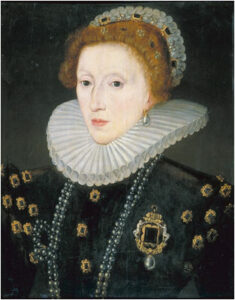
“You realise, my dearest, that the greatest difficulties lie in making our people rejoice and approve. The public practice of the Roman religion so sticks in their hearts. I beg you to consider this deeply, as a matter which is so hard for Englishmen to bear that it passes all imagination. For my part, I confess there is no prince in the world to whom I think myself more bound, nor with whom I would rather pass the years of my life, both for your rare virtues and sweet nature. With my commendations to my dearest Frog.”9
How poignant.
A Charade
The Duke’s hopes of marrying Elizabeth were reawakened in 1581, when Elizabeth saw the need to ally herself with France. He visited Elizabeth in the November and the couple became all lovey dovey once more, being inseparable. Elizabeth called the Duke her “Prince Frog”, kissed him in public and pledged publicly to marry him, exchanging rings as a sign of their pledge. She refused, however, to fund the Duke’s venture in the Netherlands so the French King, Henri III, refused to agree to the marriage, something which allowed Elizabeth to wriggle out of the marriage but save face. The Duke was heartbroken and refused to leave, so Elizabeth was forced to pay him to leave. He finally left England in February 1582 leaving a seemingly heartbroken Elizabeth. Although Elizabeth kept up the charade that she was still contemplating marriage to the Duke, to keep Spain on their toes, this really was an end to the marriage negotiations and to the 48 year old queen’s days of courting.
The Death of the Frog
On the 10th of June 1584, Elizabeth’s “Frog”, the Duke of Anjou, died at Chateau-Thierry in his homeland of France. He died of a fever. When the Queen heard of his death, she was grief-stricken and was said to have wept publicly for three whole weeks. She wore black for six months and described herself to the French ambassador as “a widow woman who has lost her husband.” Even though Elizabeth had “played” with the Duke and kept the charade of their relationship going for her own purpose, she had obviously had genuine feelings for him and his death hit her hard. Whether it was simple grief or grief mixed with the realisation that she would never be a wife and mother, we will never know, but it was grief nonetheless.
Notes and Sources
- Elizabeth the Queen by Alison Weir, p318
- Ibid.,p319
- Ibid.
- Ibid.,p324
- Ibid.
- Ibid.,p326
- Ibid.
- Elizabeth I: Collected Works, p302
- Elizabeth the Queen by Alison Weir, p330
